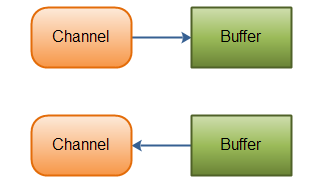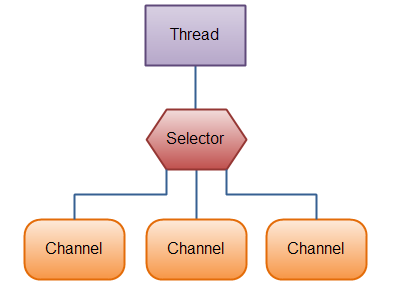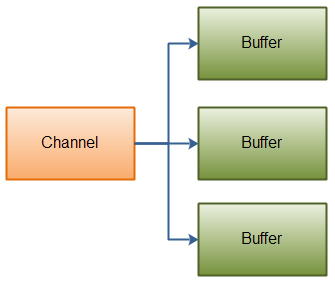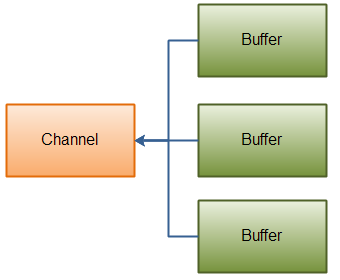Java NIO
一、概述
NIO (JDK1.5 new IO) 主要有三大核心部分:
- Channel(通道)
- Buffer(缓冲区)
- Selector(选择器)
传统IO 基于 字节流 和 字符流进行操作,而 NIO 基于Channel 和 Buffer(缓冲区)进行操作,数据总是从通道读取到缓冲区中,或者从缓冲区写入到通道中。Selector(选择器)用于监听多个通道的事件(比如:连接打开,数据到达)。因此,单个线程可以监听多个数据通道。
NIO 和 传统IO(一下简称IO)之间第一个最大的区别是,IO是面向流的,NIO是面向缓冲区的。 Java IO面向流意味着每次从流中读一个或多个字节,直至读取所有字节,它们没有被缓存在任何地方。此外,它不能前后移动流中的数据。如果需要前后移动从流中读取的数据,需要先将它缓存到一个缓冲区。NIO的缓冲导向方法略有不同。数据读取到一个它稍后处理的缓冲区,需要时可在缓冲区中前后移动。这就增加了处理过程中的灵活性。但是,还需要检查是否该缓冲区中包含所有您需要处理的数据。而且,需确保当更多的数据读入缓冲区时,不要覆盖缓冲区里尚未处理的数据。
IO的各种流是阻塞的。这意味着,当一个线程调用 read() 或 write()时,该线程被阻塞,直到有一些数据被读取,或数据完全写入。该线程在此期间不能再干任何事情了。 NIO的非阻塞模式,使一个线程从某通道发送请求读取数据,但是它仅能得到目前可用的数据,如果目前没有数据可用时,就什么都不会获取。而不是保持线程阻塞,所以直至数据变得可以读取之前,该线程可以继续做其他的事情。 非阻塞写也是如此。一个线程请求写入一些数据到某通道,但不需要等待它完全写入,这个线程同时可以去做别的事情。 线程通常将非阻塞IO的空闲时间用于在其它通道上执行IO操作,所以一个单独的线程现在可以管理多个输入和输出通道(Channel)。
Channel 和 Buffer简介
基本上,所有的 IO 在NIO 中都从一个Channel 开始。Channel 有点象流。 数据可以从Channel读到Buffer中,也可以从Buffer 写到Channel中。如图所示:

Channel 和 IO中的 Stream(流)是差不多一个等级的。只不过Stream是单向的,譬如:InputStream, OutputStream。 而Channel是双向的,既可以用来进行读操作,又可以用来进行写操作。
NIO中的Channel的主要实现有:
Channel 和 Buffer 有好几种类型。下面是JAVA NIO中的一些主要 Channel 的实现:
- FileChannel (文件IO)
- DatagramChannel (UDP)
- SocketChannel (Client TCP)
- ServerSocketChannel (Server TCP)
以下是Java NIO里关键的 Buffer 实现(Buffer的类型):
- ByteBuffer
- CharBuffer
- DoubleBuffer
- FloatBuffer
- IntBuffer
- LongBuffer
- ShortBuffer
这些Buffer覆盖了你能通过IO发送的基本数据类型:byte、short、 int、 long、 float、 double 和 char。
Java NIO 还有个 MappedByteBuffer,用于表示内存映射文件。后面会讲到。
Selector 简介
Selector 运行单线程处理多个Channel,如果你的应用打开了多个通道,但每个连接的流量都很低,使用Selector就会很方便。例如在一个聊天服务器中。要使用Selector, 得向Selector注册Channel,然后调用它的 select()方法。这个方法会一直阻塞到某个注册的通道有事件就绪。一旦这个方法返回,线程就可以处理这些事件,事件的例子有如新的连接进来、数据接收等。

二、FileChannel (文件IO)
传统IO 与 FileChannel (NIO) 读取文件并输出代码比较:
传统:IO
public static void Io(){
InputStream in = null;
try{
in = new BufferedInputStream(new FileInputStream("src/nomal_io.txt"));
byte [] buf = new byte[1024];
// 读取数据到缓冲区
int bytesRead = in.read(buf);
while(bytesRead != -1)
{
for(int i=0;i<bytesRead;i++)
System.out.print((char)buf[i]);
bytesRead = in.read(buf);
}
}catch (IOException e)
{
e.printStackTrace();
}finally{
try{
if(in != null){
in.close();
}
}catch (IOException e){
e.printStackTrace();
}
}
}
NIO :
public static void Nio(){
RandomAccessFile aFile = null;
try{
aFile = new RandomAccessFile("src/nio.txt","rw");
FileChannel fileChannel = aFile.getChannel();
// 创建 1024 字节的缓冲区
ByteBuffer buf = ByteBuffer.allocate(1024);
// 从通道中读取数据到 缓冲区中
int bytesRead = fileChannel.read(buf);
System.out.println(bytesRead);
while(bytesRead != -1)
{
// 切换缓冲区的模式为读模式
buf.flip();
// 当缓冲区 buf 中有数据则一直循环
while(buf.hasRemaining())
{
System.out.print((char)buf.get());
}
// 清空缓存区
buf.compact();
// 继续读取文件流到缓冲区中, 返回读取的字节数
bytesRead = fileChannel.read(buf);
}
}catch (IOException e){
e.printStackTrace();
}finally{
try{
if(aFile != null){
aFile.close();
}
}catch (IOException e){
e.printStackTrace();
}
}
}
可以看出,使用 NIO 的实现方式相对复杂一点。
三、Buffer的基本用法
使用Buffer读写数据一般遵循以下几个步骤:
1、分配空间(分配1024 字节capacity ByteBuffer buf = ByteBuffer.allocate(1024); )。
2、写入数据到 Buffer:
-
- 从Channel 写到 Buffer ( fileChannel.read(buf) )
-
- 通过 Buffer的 put()方法 (buf.put(…))
3、调用 flip()方法,将Buffer从写模式切换到读模式。
4、从 Buffer 中读取数据:
-
- 从Buffer读取到Channel ( fileChannel.write(buf) ;)
-
- 使用get()方法从Buffer中读取数据 (buf.get();)
5、调用 clear()方法或者 compact()方法。 一旦读完了所有的数据,就需要清空缓冲区,让它可以再次被写入。有两种方式能清空缓冲区:调用clear()或compact()方法。clear()方法会清空整个缓冲区。compact()方法只会清除已经读过的数据。任何未读的数据都被移到缓冲区的起始处,新写入的数据将放到缓冲区未读数据的后面。
理解 Buffer的 capacity、position和limit 属性
缓冲区本质上是一块可以写入数据,然后可以从中读取数据的内存。这块内存被包装成NIO Buffer对象,并提供了一组方法,用来方便的访问该块内存。
capacity:
- 作为一个内存块,Buffer有一个固定的大小值,也叫“capacity”.你只能往里写capacity个byte、long,char等类型。一旦Buffer满了,需要将其清空(通过读数据或者清除数据)才能继续写数据往里写数据。
position:
- 当你写数据到Buffer中时,position表示当前的位置。初始的position值为0.当一个byte、long等数据写到Buffer后, position会向前移动到下一个可插入数据的Buffer单元。position最大可为capacity – 1.
- 当读取数据时,也是从某个特定位置读。当将Buffer从写模式切换到读模式,position会被重置为0. 当从Buffer的position处读取数据时,position向前移动到下一个可读的位置。
limit:
- 在写模式下,Buffer的limit表示你最多能往Buffer里写多少数据。 写模式下,limit等于Buffer的capacity。
- 当切换Buffer到读模式时, limit表示你最多能读到多少数据。因此,当切换Buffer到读模式时,limit会被设置成写模式下的position值。换句话说,你能读到之前写入的所有数据(limit被设置成已写数据的数量,这个值在写模式下就是position)
Buffer 的其他方法:
rewind()方法:
Buffer.rewind() 将position设回0,所以你可以重读Buffer中的所有数据。limit保持不变,仍然表示能从Buffer中读取多少个元素(byte、char等)。
clear()与compact()方法:
一旦读完Buffer中的数据,需要让Buffer准备好再次被写入。可以通过clear()或compact()方法来完成。
如果调用的是clear()方法,position将被设回0,limit被设置成 capacity的值。换句话说,Buffer 被清空了。Buffer中的数据并未清除,只是这些标记告诉我们可以从哪里开始往Buffer里写数据。
如果Buffer中有一些未读的数据,调用clear()方法,数据将“被遗忘”,意味着不再有任何标记会告诉你哪些数据被读过,哪些还没有。
如果Buffer中仍有未读的数据,且后续还需要这些数据,但是此时想要先先写些数据,那么使用compact()方法。
compact()方法将所有未读的数据拷贝到Buffer起始处。然后将position设到最后一个未读元素正后面。limit属性依然像clear()方法一样,设置成capacity。现在Buffer准备好写数据了,但是不会覆盖未读的数据。
mark()与reset()方法:
通过调用Buffer.mark()方法,可以标记Buffer中的一个特定position。之后可以通过调用Buffer.reset()方法恢复到这个position。例如:
buffer.mark();
//call buffer.get() a couple of times, e.g. during parsing.
buffer.reset(); //set position back to mark.
四、NIO Channel (通道)间的数据传输
在Java NIO中,如果两个通道中有一个是FileChannel,那你可以直接将数据从一个channel(译者注:channel中文常译作通道)传输到另外一个channel。
1、 transferFrom()
FileChannel 的 transferFrom() 方法可以将数据从源通道传输到FileChannel中(译者注:这个方法在JDK文档中的解释为将字节从给定的可读取字节通道传输到此通道的文件中)。下面是一个简单的例子:
RandomAccessFile fromFile = new RandomAccessFile("fromFile.txt", "rw");
FileChannel fromChannel = fromFile.getChannel();
RandomAccessFile toFile = new RandomAccessFile("toFile.txt", "rw");
FileChannel toChannel = toFile.getChannel();
// 开始写入下标
long position = 0;
// 写入大小
long count = fromChannel.size();
toChannel.transferFrom(position, count, fromChannel);
方法的输入参数 position 表示从 position 处开始向目标文件写入数据,count表示最多传输的字节数。如果源通道的剩余空间小于 count 个字节,则所传输的字节数要小于请求的字节数。
此外要注意,在SoketChannel的实现中,SocketChannel只会传输此刻准备好的数据(可能不足count字节)。因此,SocketChannel可能不会将请求的所有数据(count个字节)全部传输到FileChannel中。
2、 transferTo()
transferTo() 方法将数据从FileChannel传输到其他的channel中。下面是一个简单的例子:
RandomAccessFile fromFile = new RandomAccessFile("fromFile.txt", "rw");
FileChannel fromChannel = fromFile.getChannel();
RandomAccessFile toFile = new RandomAccessFile("toFile.txt", "rw");
FileChannel toChannel = toFile.getChannel();
long position = 0;
long count = fromChannel.size();
fromChannel.transferTo(position, count, toChannel);
是不是发现这个例子和前面那个例子特别相似?除了调用方法的FileChannel对象不一样外,其他的都一样。
上面所说的关于SocketChannel的问题在transferTo()方法中同样存在。SocketChannel会一直传输数据直到目标buffer被填满。
五、SocketChannel (客户端 Tcp)
说完了FileChannel和Buffer, 大家应该对Buffer的用法比较了解了,这里使用SocketChannel来继续探讨NIO。NIO的强大功能部分来自于Channel的非阻塞特性,套接字的某些操作可能会无限期地阻塞。例如,对accept()方法的调用可能会因为等待一个客户端连接而阻塞;对read()方法的调用可能会因为没有数据可读而阻塞,直到连接的另一端传来新的数据。总的来说,创建/接收连接或读写数据等I/O调用,都可能无限期地阻塞等待,直到底层的网络实现发生了什么。慢速的,有损耗的网络,或仅仅是简单的网络故障都可能导致任意时间的延迟。然而不幸的是,在调用一个方法之前无法知道其是否阻塞。NIO的channel抽象的一个重要特征就是可以通过配置它的阻塞行为,以实现非阻塞式的信道。
channel.configureBlocking(false)
在非阻塞式信道上调用一个方法总是会立即返回。这种调用的返回值指示了所请求的操作完成的程度。例如,在一个非阻塞式ServerSocketChannel上调用accept()方法,如果有连接请求来了,则返回客户端SocketChannel,否则返回null。
这里先举一个TCP应用案例,客户端采用NIO实现,而服务端依旧使用BIO实现。
客户端代码:
public static void client(){
ByteBuffer buffer = ByteBuffer.allocate(1024);
SocketChannel socketChannel = null;
try
{
socketChannel = SocketChannel.open();
socketChannel.configureBlocking(false);
socketChannel.connect(new InetSocketAddress("10.10.195.115",8080));
if(socketChannel.finishConnect())
{
int i=0;
while(true)
{
TimeUnit.SECONDS.sleep(1);
String info = "I'm "+i+++"-th information from client";
buffer.clear();
buffer.put(info.getBytes());
buffer.flip();
while(buffer.hasRemaining()){
System.out.println(buffer);
socketChannel.write(buffer);
}
}
}
}
catch (IOException | InterruptedException e)
{
e.printStackTrace();
}
finally{
try{
if(socketChannel!=null){
socketChannel.close();
}
}catch(IOException e){
e.printStackTrace();
}
}
}
服务端代码:
public static void server(){
ServerSocket serverSocket = null;
InputStream in = null;
try
{
serverSocket = new ServerSocket(8080);
int recvMsgSize = 0;
byte[] recvBuf = new byte[1024];
while(true){
Socket clntSocket = serverSocket.accept();
SocketAddress clientAddress = clntSocket.getRemoteSocketAddress();
System.out.println("Handling client at "+clientAddress);
in = clntSocket.getInputStream();
while((recvMsgSize=in.read(recvBuf))!=-1){
byte[] temp = new byte[recvMsgSize];
System.arraycopy(recvBuf, 0, temp, 0, recvMsgSize);
System.out.println(new String(temp));
}
}
}
catch (IOException e)
{
e.printStackTrace();
}
finally{
try{
if(serverSocket!=null){
serverSocket.close();
}
if(in!=null){
in.close();
}
}catch(IOException e){
e.printStackTrace();
}
}
}
方法解析:
Java NIO中的SocketChannel是一个连接到TCP网络套接字的通道。可以通过以下2种方式创建 SocketChannel:
- 打开一个SocketChannel并连接到互联网上的某台服务器。
- 一个新连接到达ServerSocketChannel时,会创建一个SocketChannel。
1、打开 SocketChannel
下面是SocketChannel的打开方式:
SocketChannel socketChannel = SocketChannel.open();
socketChannel.connect(new InetSocketAddress("http://jenkov.com", 80));
2、关闭 SocketChannel
当用完SocketChannel之后调用 SocketChannel.close()关闭SocketChannel:
socketChannel.close();
3、从 SocketChannel 读取数据
要从SocketChannel中读取数据,调用一个 read()的方法之一。以下是例子:
ByteBuffer buf = ByteBuffer.allocate(48);
int bytesRead = socketChannel.read(buf);
首先,分配一个Buffer。从SocketChannel读取到的数据将会放到这个Buffer中。
然后,调用SocketChannel.read()。该方法将数据从SocketChannel 读到Buffer中。read()方法返回的int值表示读了多少字节进Buffer里。如果返回的是-1,表示已经读到了流的末尾(连接关闭了)。
4、写入 SocketChannel
写数据到 SocketChannel 用的是 SocketChannel.write()方法,该方法以一个Buffer作为参数。示例如下:
String newData = "New String to write to file..." + System.currentTimeMillis();
ByteBuffer buf = ByteBuffer.allocate(48);
buf.clear();
buf.put(newData.getBytes());
buf.flip();
while(buf.hasRemaining()) {
channel.write(buf);
}
注意SocketChannel.write()方法的调用是在一个while循环中的。Write()方法无法保证能写多少字节到SocketChannel。所以,我们重复调用write()直到Buffer没有要写的字节为止。
5、非阻塞模式
可以设置 SocketChannel 为非阻塞模式(non-blocking mode).设置之后,就可以在异步模式下调用connect(), read() 和write()了。
5.1、connect()
如果SocketChannel在非阻塞模式下,此时调用connect(),该方法可能在连接建立之前就返回了。为了确定连接是否建立,可以调用finishConnect()的方法。像这样:
socketChannel.configureBlocking(false);
socketChannel.connect(new InetSocketAddress("http://jenkov.com", 80));
while(! socketChannel.finishConnect() ){
//wait, or do something else...
}
5.2、write()
- 非阻塞模式下,write()方法在尚未写出任何内容时可能就返回了。所以需要在循环中调用write()。前面已经有例子了,这里就不赘述了。
5.3、read()
非阻塞模式下,read()方法在尚未读取到任何数据时可能就返回了。所以需要关注它的int返回值,它会告诉你读取了多少字节。
非阻塞模式与选择器
非阻塞模式与选择器搭配会工作的更好,通过将一或多个SocketChannel注册到Selector,可以询问选择器哪个通道已经准备好了读取,写入等。Selector与SocketChannel的搭配使用会在后面详讲。
六、ServerSocketChannel
Java NIO中的 ServerSocketChannel 是一个可以监听新进来的TCP连接的通道, 就像标准IO中的ServerSocket一样。ServerSocketChannel类在 java.nio.channels包中。
这里有个例子:
ServerSocketChannel serverSocketChannel = ServerSocketChannel.open();
serverSocketChannel.socket().bind(new InetSocketAddress(9999));
while(true){
SocketChannel socketChannel = serverSocketChannel.accept();
//do something with socketChannel...
}
1、打开 ServerSocketChannel
通过调用 ServerSocketChannel.open() 方法来打开ServerSocketChannel.如:
ServerSocketChannel serverSocketChannel = ServerSocketChannel.open();
2、关闭 ServerSocketChannel
通过调用ServerSocketChannel.close() 方法来关闭ServerSocketChannel. 如:
serverSocketChannel.close();
3、监听新进来的连接
通过 ServerSocketChannel.accept() 方法监听新进来的连接。当 accept()方法返回的时候,它返回一个包含新进来的连接的 SocketChannel。因此, accept()方法会一直阻塞到有新连接到达。
通常不会仅仅只监听一个连接,在while循环中调用 accept()方法. 如下面的例子:
while(true){
SocketChannel socketChannel = serverSocketChannel.accept();
//do something with socketChannel...
}
当然,也可以在while循环中使用除了true以外的其它退出准则。
4、非阻塞模式
ServerSocketChannel可以设置成非阻塞模式。在非阻塞模式下,accept() 方法会立刻返回,如果还没有新进来的连接,返回的将是null。 因此,需要检查返回的SocketChannel是否是null.如:
ServerSocketChannel serverSocketChannel = ServerSocketChannel.open();
serverSocketChannel.socket().bind(new InetSocketAddress(9999));
serverSocketChannel.configureBlocking(false);
while(true){
SocketChannel socketChannel = serverSocketChannel.accept();
if(socketChannel != null){
//do something with socketChannel...
}
}
下面将上面的TCP服务端代码改写成NIO的方式:
public class ServerConnect
{
private static final int BUF_SIZE=1024;
private static final int PORT = 8080;
private static final int TIMEOUT = 3000;
public static void main(String[] args)
{
selector();
}
public static void handleAccept(SelectionKey key) throws IOException{
ServerSocketChannel ssChannel = (ServerSocketChannel)key.channel();
SocketChannel sc = ssChannel.accept();
sc.configureBlocking(false);
sc.register(key.selector(), SelectionKey.OP_READ,ByteBuffer.allocateDirect(BUF_SIZE));
}
public static void handleRead(SelectionKey key) throws IOException{
SocketChannel sc = (SocketChannel)key.channel();
ByteBuffer buf = (ByteBuffer)key.attachment();
long bytesRead = sc.read(buf);
while(bytesRead>0){
buf.flip();
while(buf.hasRemaining()){
System.out.print((char)buf.get());
}
System.out.println();
buf.clear();
bytesRead = sc.read(buf);
}
if(bytesRead == -1){
sc.close();
}
}
public static void handleWrite(SelectionKey key) throws IOException{
ByteBuffer buf = (ByteBuffer)key.attachment();
buf.flip();
SocketChannel sc = (SocketChannel) key.channel();
while(buf.hasRemaining()){
sc.write(buf);
}
buf.compact();
}
public static void selector() {
Selector selector = null;
ServerSocketChannel ssc = null;
try{
selector = Selector.open();
ssc= ServerSocketChannel.open();
ssc.socket().bind(new InetSocketAddress(PORT));
ssc.configureBlocking(false);
ssc.register(selector, SelectionKey.OP_ACCEPT);
while(true){
if(selector.select(TIMEOUT) == 0){
System.out.println("==");
continue;
}
Iterator<SelectionKey> iter = selector.selectedKeys().iterator();
while(iter.hasNext()){
SelectionKey key = iter.next();
if(key.isAcceptable()){
handleAccept(key);
}
if(key.isReadable()){
handleRead(key);
}
if(key.isWritable() && key.isValid()){
handleWrite(key);
}
if(key.isConnectable()){
System.out.println("isConnectable = true");
}
iter.remove();
}
}
}catch(IOException e){
e.printStackTrace();
}finally{
try{
if(selector!=null){
selector.close();
}
if(ssc!=null){
ssc.close();
}
}catch(IOException e){
e.printStackTrace();
}
}
}
}
七、Selector(选择器)
Selector(选择器)是Java NIO中能够检测一到多个NIO通道,并能够知晓通道是否为诸如读写事件做好准备的组件。这样,一个单独的线程可以管理多个channel,从而管理多个网络连接。
1、为什么使用Selector?
仅用单个线程来处理多个Channels的好处是,只需要更少的线程来处理通道。事实上,可以只用一个线程处理所有的通道。对于操作系统来说,线程之间上下文切换的开销很大,而且每个线程都要占用系统的一些资源(如内存)。因此,使用的线程越少越好。
但是,需要记住,现代的操作系统和CPU在多任务方面表现的越来越好,所以多线程的开销随着时间的推移,变得越来越小了。实际上,如果一个CPU有多个内核,不使用多任务可能是在浪费CPU能力。在这里,只要知道使用Selector能够处理多个通道就足够了。
2、Selector的创建
通过调用Selector.open()方法创建一个Selector,如下:
Selector selector = Selector.open();
3、向Selector注册通道
为了将Channel和Selector配合使用,必须将channel注册到selector上。通过SelectableChannel.register()方法来实现,如下
channel.configureBlocking(false); SelectionKey key = channel.register(selector, Selectionkey.OP_READ);
与Selector一起使用时,Channel必须处于非阻塞模式下。这意味着不能将FileChannel与Selector一起使用,因为FileChannel不能切换到非阻塞模式。而套接字通道都可以。
注意register()方法的第二个参数。这是一个“interest集合”,意思是在通过Selector监听Channel时对什么事件感兴趣。可以监听四种不同类型的事件:
- Connect
- Accept
- Read
- Write
通道触发了一个事件意思是该事件已经就绪。所以,某个channel成功连接到另一个服务器称为“连接就绪”。一个server socket channel准备好接收新进入的连接称为“接收就绪”。一个有数据可读的通道可以说是“读就绪”。等待写数据的通道可以说是“写就绪”。
这四种事件用SelectionKey的四个常量来表示:
- SelectionKey.OP_CONNECT
- SelectionKey.OP_ACCEPT
- SelectionKey.OP_READ
- SelectionKey.OP_WRITE
如果你对不止一种事件感兴趣,那么可以用“位或”操作符将常量连接起来,如下:
int interestSet = SelectionKey.OP_READ | SelectionKey.OP_WRITE;
在下面还会继续提到interest集合。
SelectionKey
在上一小节中,当向Selector注册Channel时,register()方法会返回一个SelectionKey对象。这个对象包含了一些你感兴趣的属性:
- interest集合
- ready集合
- Channel
- Selector
- 附加的对象(可选)
下面我会描述这些属性:
interest集合
就像向Selector注册通道一节中所描述的,interest集合是你所选择的感兴趣的事件集合。可以通过SelectionKey读写interest集合,像这样
int interestSet = selectionKey.interestOps();
boolean isInterestedInAccept = (interestSet & SelectionKey.OP_ACCEPT) == SelectionKey.OP_ACCEPT;
boolean isInterestedInConnect = interestSet & SelectionKey.OP_CONNECT;
boolean isInterestedInRead = interestSet & SelectionKey.OP_READ;
boolean isInterestedInWrite = interestSet & SelectionKey.OP_WRITE;
可以看到,用“位与”操作interest 集合和给定的SelectionKey常量,可以确定某个确定的事件是否在interest 集合中。
ready集合
ready 集合是通道已经准备就绪的操作的集合。在一次选择(Selection)之后,你会首先访问这个ready set。可以这样访问ready集合:
int readySet = selectionKey.readyOps();
可以用像检测interest集合那样的方法,来检测channel中什么事件或操作已经就绪。但是,也可以使用以下四个方法,它们都会返回一个布尔类型:
- selectionKey.isAcceptable();
- selectionKey.isConnectable();
- selectionKey.isReadable();
- selectionKey.isWritable();
Channel + Selector
从SelectionKey访问Channel和Selector很简单。如下:
Channel channel = selectionKey.channel();
Selector selector = selectionKey.selector();
附加的对象
可以将一个对象或者更多信息附着到SelectionKey上,这样就能方便的识别某个给定的通道。例如,可以附加 与通道一起使用的Buffer,或是包含聚集数据的某个对象。使用方法如下:
selectionKey.attach(theObject);
Object attachedObj = selectionKey.attachment();
还可以在用register()方法向Selector注册Channel的时候附加对象。如:
SelectionKey key = channel.register(selector, SelectionKey.OP_READ, theObject);
4、通过Selector选择通道
一旦向Selector注册了一或多个通道,就可以调用几个重载的select()方法。这些方法返回你所感兴趣的事件(如连接、接受、读或写)已经准备就绪的那些通道。换句话说,如果你对“读就绪”的通道感兴趣,select()方法会返回读事件已经就绪的那些通道。
下面是select()方法:
- int select()
- int select(long timeout)
- int selectNow()
select() 阻塞到至少有一个通道在你注册的事件上就绪了。
select(long timeout)和select()一样,除了最长会阻塞timeout毫秒(参数)。
selectNow()不会阻塞,不管什么通道就绪都立刻返回(译者注:此方法执行非阻塞的选择操作。如果自从前一次选择操作后,没有通道变成可选择的,则此方法直接返回零。)。
select()方法返回的int值表示有多少通道已经就绪。亦即,自上次调用select()方法后有多少通道变成就绪状态。如果调用select()方法,因为有一个通道变成就绪状态,返回了1,若再次调用select()方法,如果另一个通道就绪了,它会再次返回1。如果对第一个就绪的channel没有做任何操作,现在就有两个就绪的通道,但在每次select()方法调用之间,只有一个通道就绪了。
5、selectedKeys()
一旦调用了select()方法,并且返回值表明有一个或更多个通道就绪了,然后可以通过调用selector的selectedKeys()方法,访问“已选择键集(selected key set)”中的就绪通道。如下所示:
Set selectedKeys = selector.selectedKeys();
当像Selector注册Channel时,Channel.register()方法会返回一个SelectionKey 对象。这个对象代表了注册到该Selector的通道。可以通过SelectionKey的selectedKeySet()方法访问这些对象。
可以遍历这个已选择的键集合来访问就绪的通道。如下:
Set selectedKeys = selector.selectedKeys(); Iterator keyIterator = selectedKeys.iterator(); while(keyIterator.hasNext()) { SelectionKey key = keyIterator.next(); if(key.isAcceptable()) { // a connection was accepted by a ServerSocketChannel. } else if (key.isConnectable()) { // a connection was established with a remote server. } else if (key.isReadable()) { // a channel is ready for reading } else if (key.isWritable()) { // a channel is ready for writing } keyIterator.remove(); }
这个循环遍历已选择键集中的每个键,并检测各个键所对应的通道的就绪事件。
注意每次迭代末尾的keyIterator.remove()调用。Selector不会自己从已选择键集中移除SelectionKey实例。必须在处理完通道时自己移除。下次该通道变成就绪时,Selector会再次将其放入已选择键集中。
SelectionKey.channel()方法返回的通道需要转型成你要处理的类型,如ServerSocketChannel或SocketChannel等。
6、wakeUp()
某个线程调用select()方法后阻塞了,即使没有通道已经就绪,也有办法让其从select()方法返回。只要让其它线程在第一个线程调用select()方法的那个对象上调用Selector.wakeup()方法即可。阻塞在select()方法上的线程会立马返回。
如果有其它线程调用了wakeup()方法,但当前没有线程阻塞在select()方法上,下个调用select()方法的线程会立即“醒来(wake up)”。
7、close()
用完Selector后调用其close()方法会关闭该Selector,且使注册到该Selector上的所有SelectionKey实例无效。通道本身并不会关闭。
完整的示例:
这里有一个完整的示例,打开一个Selector,注册一个通道注册到这个Selector上(通道的初始化过程略去),然后持续监控这个Selector的四种事件(接受,连接,读,写)是否就绪。
Selector selector = Selector.open();
channel.configureBlocking(false);
SelectionKey key = channel.register(selector, SelectionKey.OP_READ);
while(true) {
int readyChannels = selector.select();
if(readyChannels == 0) continue;
Set selectedKeys = selector.selectedKeys();
Iterator keyIterator = selectedKeys.iterator();
while(keyIterator.hasNext()) {
SelectionKey key = keyIterator.next();
if(key.isAcceptable()) {
// a connection was accepted by a ServerSocketChannel.
} else if (key.isConnectable()) {
// a connection was established with a remote server.
} else if (key.isReadable()) {
// a channel is ready for reading
} else if (key.isWritable()) {
// a channel is ready for writing
}
keyIterator.remove();
}
}
八、MappedByteBuffer (内存映射文件):
JAVA处理大文件,一般用BufferedReader,BufferedInputStream这类带缓冲的IO类,不过如果文件超大的话,更快的方式是采用MappedByteBuffer。MappedByteBuffer是NIO引入的文件内存映射方案(这里的内存指的是虚拟内存,并不是物理内存),是ByteBuffer的子类,读写性能极高。如果我要发送一个1G的文件怎么办?不可能真的去分配1G的内存.这时就必须使用 MappedByteBuffer。
注:使用MappedByteBuffer有资源释放的问题:被MappedByteBuffer打开的文件只有在垃圾收集时才会被关闭,而这个点是不确定的。
概念
FileChannel提供了map方法来把文件影射为内存映像文件: MappedByteBuffer map(int mode,long position,long size); 可以把文件的从position开始的size大小的区域映射为内存映像文件,mode指出了 可访问该内存映像文件的方式:
- READ_ONLY,(只读): 试图修改得到的缓冲区将导致抛出 ReadOnlyBufferException.(FileChannel.MapMode.READ_ONLY)
- READ_WRITE(读/写): 对得到的缓冲区的更改最终将传播到文件;该更改对映射到同一文件的其他程序不一定是可见的。 (FileChannel.MapMode.READ_WRITE)
- PRIVATE(专用): 对得到的缓冲区的更改不会传播到文件,并且该更改对映射到同一文件的其他程序也不是可见的;相反,会创建缓冲区已修改部分的专用副本。 (FileChannel.MapMode.PRIVATE)
MappedByteBuffer是ByteBuffer的子类,其扩充了三个方法:
- force():缓冲区是READ_WRITE模式下,此方法对缓冲区内容的修改强行写入文件;
- load():将缓冲区的内容载入内存,并返回该缓冲区的引用;
- isLoaded():如果缓冲区的内容在物理内存中,则返回真,否则返回假;
使用案例对比:
public static void method4(){ RandomAccessFile aFile = null; FileChannel fc = null; try{ aFile = new RandomAccessFile("src/1.ppt","rw"); fc = aFile.getChannel(); long timeBegin = System.currentTimeMillis(); ByteBuffer buff = ByteBuffer.allocate((int) aFile.length()); buff.clear(); fc.read(buff); //System.out.println((char)buff.get((int)(aFile.length()/2-1))); //System.out.println((char)buff.get((int)(aFile.length()/2))); //System.out.println((char)buff.get((int)(aFile.length()/2)+1)); long timeEnd = System.currentTimeMillis(); System.out.println("Read time: "+(timeEnd-timeBegin)+"ms"); }catch(IOException e){ e.printStackTrace(); }finally{ try{ if(aFile!=null){ aFile.close(); } if(fc!=null){ fc.close(); } }catch(IOException e){ e.printStackTrace(); } } } public static void method3(){ RandomAccessFile aFile = null; FileChannel fc = null; try{ aFile = new RandomAccessFile("src/1.ppt","rw"); fc = aFile.getChannel(); long timeBegin = System.currentTimeMillis(); MappedByteBuffer mbb = fc.map(FileChannel.MapMode.READ_ONLY, 0, aFile.length()); // System.out.println((char)mbb.get((int)(aFile.length()/2-1))); // System.out.println((char)mbb.get((int)(aFile.length()/2))); //System.out.println((char)mbb.get((int)(aFile.length()/2)+1)); long timeEnd = System.currentTimeMillis(); System.out.println("Read time: "+(timeEnd-timeBegin)+"ms"); }catch(IOException e){ e.printStackTrace(); }finally{ try{ if(aFile!=null){ aFile.close(); } if(fc!=null){ fc.close(); } }catch(IOException e){ e.printStackTrace(); } } }
测试一个200M的文件读取,输出结果: method3 耗时: 1ms, method4耗时400ms。
九、Pipe
Java NIO 管道是2个线程之间的单向数据连接。Pipe有一个source通道和一个sink通道。数据会被写到sink通道,从source通道读取。
这里是Pipe原理的图示:

1、创建管道
通过Pipe.open()方法打开管道。例如:
Pipe pipe = Pipe.open();
2、向管道写数据
要向管道写数据,需要访问sink通道。像这样:
Pipe.SinkChannel sinkChannel = pipe.sink();
通过调用SinkChannel的write()方法,将数据写入SinkChannel,像这样:
String newData = "New String to write to file..." + System.currentTimeMillis(); ByteBuffer buf = ByteBuffer.allocate(48); buf.clear(); buf.put(newData.getBytes()); buf.flip(); while(buf.hasRemaining()) { sinkChannel.write(buf); }
3、从管道读取数据
从读取管道的数据,需要访问source通道,像这样:
Pipe.SourceChannel sourceChannel = pipe.source();
调用source通道的read()方法来读取数据,像这样:
ByteBuffer buf = ByteBuffer.allocate(48); int bytesRead = sourceChannel.read(buf);
read()方法返回的int值会告诉我们多少字节被读进了缓冲区。
十、 Scatter/Gather
Java NIO开始支持scatter/gather,scatter/gather用于描述从Channel(译者注:Channel在中文经常翻译为通道)中读取或者写入到Channel的操作。
- 分散(scatter)从Channel中读取是指在读操作时将读取的数据写入多个buffer中。因此,Channel将从Channel中读取的数据“分散(scatter)”到多个Buffer中。
- 聚集(gather)写入Channel是指在写操作时将多个buffer的数据写入同一个Channel,因此,Channel 将多个Buffer中的数据“聚集(gather)”后发送到Channel。
scatter / gather经常用于需要将传输的数据分开处理的场合,例如传输一个由消息头和消息体组成的消息,你可能会将消息体和消息头分散到不同的buffer中,这样你可以方便的处理消息头和消息体。
Scattering Reads
Scattering Reads是指数据从一个channel读取到多个buffer中。如下图描述:

代码示例如下:
ByteBuffer header = ByteBuffer.allocate(128); ByteBuffer body = ByteBuffer.allocate(1024); ByteBuffer[] bufferArray = { header, body }; channel.read(bufferArray);
注意buffer首先被插入到数组,然后再将数组作为channel.read() 的输入参数。read()方法按照buffer在数组中的顺序将从channel中读取的数据写入到buffer,当一个buffer被写满后,channel紧接着向另一个buffer中写。
Scattering Reads在移动下一个buffer前,必须填满当前的buffer,这也意味着它不适用于动态消息(译者注:消息大小不固定)。换句话说,如果存在消息头和消息体,消息头必须完成填充(例如 128byte),Scattering Reads才能正常工作。
Gathering Writes
Gathering Writes是指数据从多个buffer写入到同一个channel。如下图描述:

代码示例如下:
ByteBuffer header = ByteBuffer.allocate(128); ByteBuffer body = ByteBuffer.allocate(1024); //write data into buffers ByteBuffer[] bufferArray = { header, body }; channel.write(bufferArray);
buffers数组是write()方法的入参,write()方法会按照buffer在数组中的顺序,将数据写入到channel,注意只有position和limit之间的数据才会被写入。因此,如果一个buffer的容量为128byte,但是仅仅包含58byte的数据,那么这58byte的数据将被写入到channel中。因此与Scattering Reads相反,Gathering Writes能较好的处理动态消息。